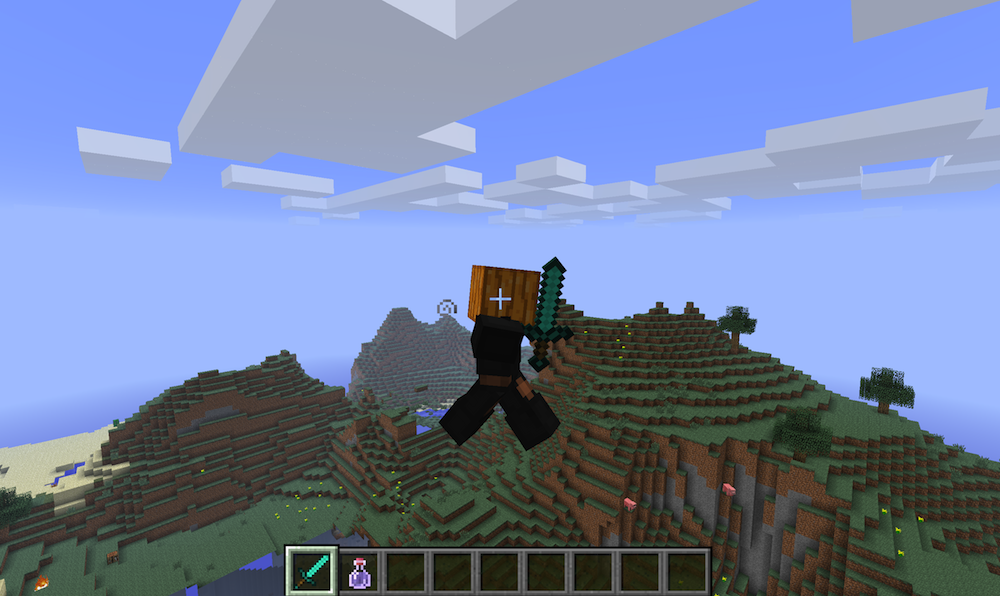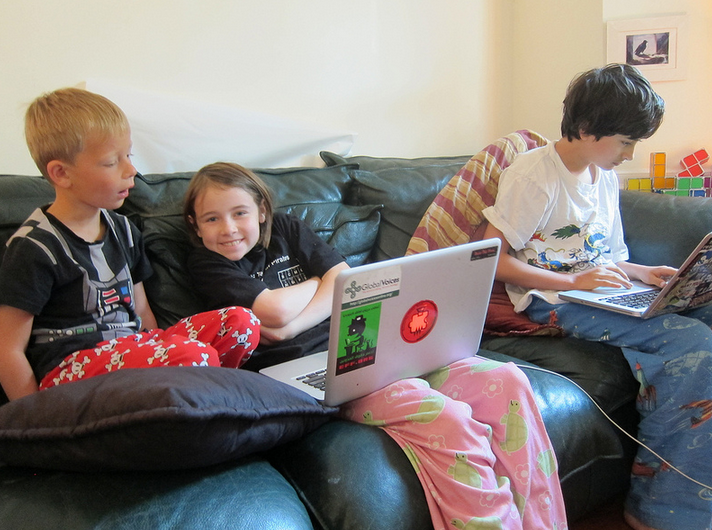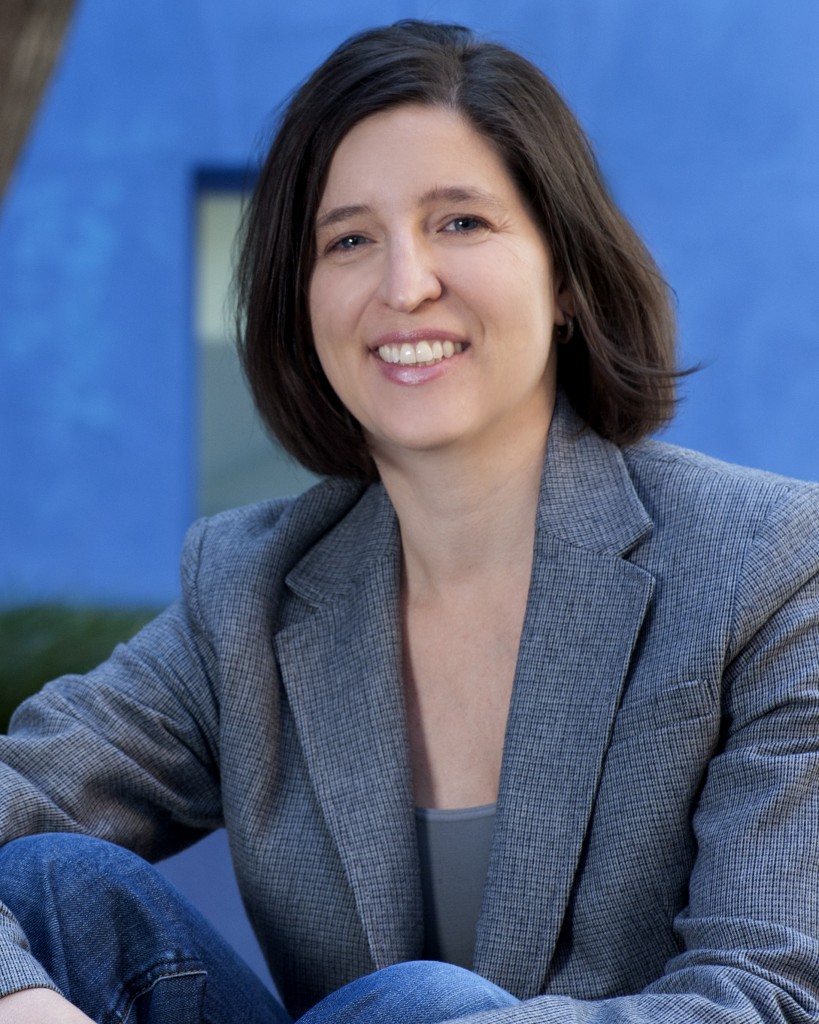It’s 7:15 on Saturday morning. Sounds are coming out of the computer room in my house where my 7 and 9 year old children are playing. “Hey-Snebmi- /tp me! You’re an op, teleport me to the castle!”
“Look, Atti just logged on.” Then there’s the familiar sound of an incoming Skype call. “Frank, let me show you the new hotel I built! I made a room for you, it is right under my command room. Your room is made out of wood and it has a floor of ice. I made you a balcony with glass!”
Saturday morning Minecraft is in full swing. The kids are playing together on a server I set up, avatars interacting with one another. The two computers in our office each have Skype sessions to different kids, including teenage cousins in a small town in the north of Holland. A third line is open on speakerphone, and walking in, it is hard to keep all the voices and chatter straight. Kids are building, destroying, blowing up TNT, killing virtual sheep and zombies, all in a virtual world. Mostly the conversation is exuberant, but there is the occasional cry of frustration. “Hey, no putting fireworks in my fortress!” “You stole my only diamond, I was saving up to make a diamond sword!” Somehow, the kids seem to work out most of their conflicts.
Minecraft is much more than your ordinary computer game. It’s virtual lego on steroids. It’s 3D design with virtual electronic circuitry. It’s an open source program where kids can create “mods” that modify the game and share their code with other players. It’s a community, complete with kid-created YouTube how-to videos, Minecraft parodies of popular songs, and ad-funded blogs created by teens. It’s an obsession. As a social game and an online experience, it creates numerous challenges for parents trying to figure out what is safe, appropriate and educational in the world of Minecraft.
Minecraft on Tablets
Most younger children come to Minecraft through tablet versions, on iOS and Android. When played in “creative” mode, it is like virtual Legos from the days before kits. Children create amazing 3D structures, and they get an unlimited supply of the resources they need to build. Relative to Lego, they can construct more complex structures with much less dexterity and patience. Without an instruction book, it is open-ended design that encourages the imagination.
Moving into “survival” mode on the tablet version, the game can become more frustrating for early elementary kids but also more exciting for tweens. The characters need sleep and food to survive, so they farm and hunt. Sometimes it rains and storms, unleashing hostile creatures. Zombies attack, and the kids battle them with swords.
When my children discovered that they could play multi-player Minecraft on tablets, a whole new world opened up. As long as all devices are on the same local area network (e.g. the WiFi network in your home), they can join the same “world” and interact with one another. They collaborate on buildings, but can also steal things from each others’ “chests” or destroy their carefully crafted creations. Kids get exuberant but occasionally frustrated too.
Minecraft Media and Internet Exploration
At school, my kids started hearing about great YouTube channels for watching Minecraft videos. Kids give a voice-over while demonstrating features or creations on Minecraft. The problem here is that many of these videos are narrated by foul-mouthed teenagers. Beyond just profanity, the voice-over can be misogynistic. I discovered this the hard way when my son was home sick and I let him play Minecraft while I took confererence calls. I checked in, and was more than a little shocked at the words coming out of the iPad! After that, my kids could only watch YouTube Minecraft videos with the sound off.
There are also YouTube videos of Minecraft-themed parodies of popular songs. Most of the parodies I have heard are pretty harmless, but the original lyrics can be offensive, and if your kids start searching for them, you never know what might turn up. On the plus side, my son and their friends made a terrific parody of their own for Mother’s Day—so Minecraft even inspired literary creativity!
Minecraft on PCs
The decision to move to the PC versions of the game—available on Windows and Macintosh—is a significant one. New possibilities and new pitfalls emerge. First of all, unlike the tablet version, you have to pay about $28 to get a Minecraft account (and choose the username carefully, as it is used in the game and you can’t change it!). If kids want to play on the same server simultaneously, you need one account per child.
Using the PC version, you can join public or private servers over the internet—opening the door to the kind of group Minecraft sessions we have on Saturday mornings. Setting up a private Minecraft server takes some work and computer savvy, as well as a computer you don’t mind leaving on for the kids to use. It also involves changing firewall settings. An easier but more expensive option is to rent a server from a hosting company, such as Fragnet. For $8-$15/month, you can rent a server that is always on and pre-configured for Minecraft, with a nice user interface, easy-to-use menus, allows invitation-only membership, and backup capabilities.
Once kids are playing on a server, additional complications follow. The kids try to coordinate their play time with others. On weeknights, that can be especially complicated. Lots of drama can emerge when a friend joins two minutes before screen time is up, or a kid doesn’t finish homework in time to meet friends online. I decided to focus multi-player sessions on the weekend mornings to simplify.
After kids start playing on servers with friends, they will almost surely start asking if they can play on public servers. Public servers are just that—public! Most of the players are teenage boys. The players can fight, steal, enter competitions, and trash-talk over the text message feature. I have seen a fair bit of foul language, and the games themselves are often battles. It is possible to paste a web link into chat for a user to click on. We started out forbidding public servers, but my kids were introduced to a particular one at a programming camp they attended. Now we let them use that one, though I do see things like “wtf” coming across in text chats, they haven’t had other problems. I do keep an eye on it while they use it and try to encourage the kids to use our private server instead.
The PC version also enables a number of other educational opportunities, such as:
- Designing circuits to do things as simple as provide lighting for a virtual house, and as complex as designing combination locks or booby traps using logic gates. It is an introductory course in electrical engineering disguised as a video game!
- Using and then creating “mods” to change the objects in the game, which requires Java programming
- Designing objects for 3D printing that can be printed on a home 3D printer or using an online printing service. Minecraft is also an introductory course in computer aided design.
Final Words
Overall, Minecraft has many advantages over the typical games that attract elementary age kids and above. The violence is relatively minimal, and the opportunities for creativity are unparalleled. Kids may be motivated to program, design, and engage in collaborative, open-ended play. Children of multiple ages can play together—my children have forged a terrific relationship with their teenage cousins in Holland, whom they’ve only met once and where they might otherwise have little in common. The oldest Dutch cousin helps administer the server, which gives him additional challenges and responsibilities, among them keeping order and balancing demands from a rowdy set of younger kids. He entrusted the youngest regular, my seven year old daughter, with special responsibilities and privileges as an “op,” or operator. So far, she has not abused the power that brings, despite occasional temptation!
Minecraft may not be quite as good an experience as designing and building a real-life tree fort with a multi-aged group of neighborhood kids on a summer afternoon, but it is vastly more creative than most of the alternative video game fare. That creates a final challenge for parents: how to count “Minecraft time” when screen time is limited. In my house, we ended up with more screen time than before, because I saw many positives from the experience. But that can be a slippery slope, so enter the world of Minecraft with your eyes open!
Offical minecraft site:
Tips for getting started:
- http://www.diygamer.com/2010/09/minecraft-starter-guide-extra-survival-tips/
- http://gaming.stackexchange.com/questions/7744/what-persists-after-a-respawn-in-minecraft
- http://minecraft.gamepedia.com/Tutorials/Tips_and_tricks
Introduction to multiplayer Minecraft:
Hosted servers:
Posted on 1/8/2014
Susan Athey is an economics professor at Stanford Graduate School of Business, where her research and teaching focus on the economics of the internet, online advertising and news media, and the statistical analysis of big data. In 2006 she became the first woman to win the John Bates Clark Medal for the best American economist under the age of 40. She was inducted into the National Academy of Science in 2013. She is a long-term consultant to Microsoft, and also advises a few technology startups. She lives in Palo Alto, California with her husband and three young children. She loves sharing her passion for technology with kids, while navigating all of the challenges that creates.














Leave A Comment
You must be logged in to post a comment.